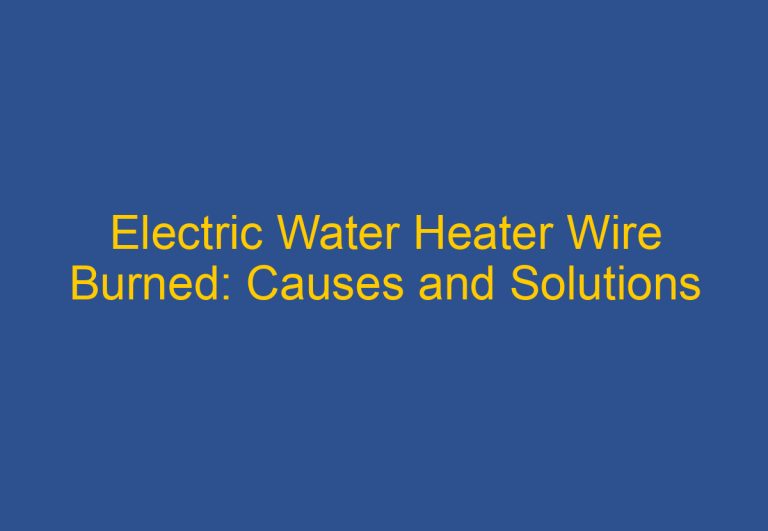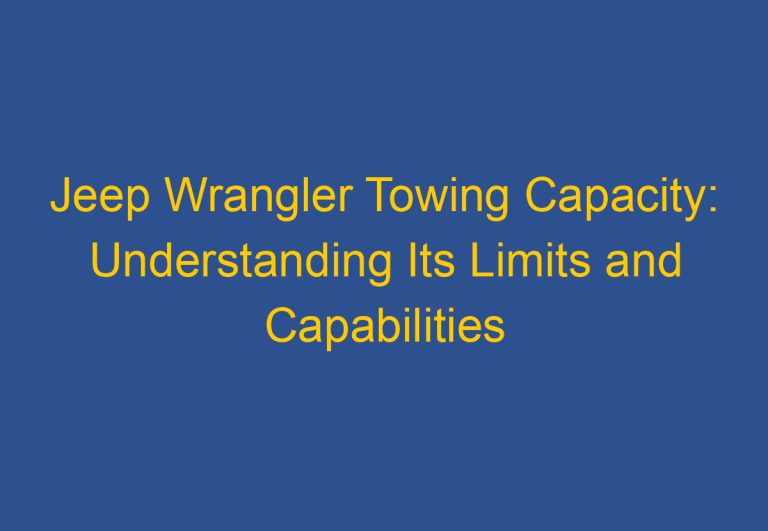What Size Gas Line for Generator: A Comprehensive Guide
Installing a new generator can be a daunting task, and the process of selecting the right gas line size can be overwhelming. This is why it is important to have a basic understanding of what size gas line for generator you should use for your system and why. The size of the gas line mainly depends on the motor power and the length of the pipeline.
Gas lines are crucial for natural gas and LP vapor transport, and having a properly sized gas line can enhance generator performance and reduce energy loss. While a certified plumber can fit your gas lines in most states and provinces, having prior knowledge about them can make the process much more convenient. In this article, we will explore the factors that determine the appropriate gas line size for your generator.
What Size Gas Line For Generator
When it comes to what size gas line for a generator, there are a few factors to consider before deciding on the appropriate size. These factors include engine power, code requirements, length of the maximum run of the pipe, and any specific manufacturer requirements.
Engine Power
The engine power of the generator is one of the primary factors that determine the size of the gas line. For generators with less than 5 kW power, a .5 to .75-inch pipe is sufficient. However, for more powerful engines (10kW<), a pipe size of .75 to 1.5 inches is necessary, depending on the length of the gas line from the gas inlet or source.
Length Of The Maximum Run Of The Pipe
The length of the maximum run of the pipe is another crucial factor to consider when determining the size of the gas line. If the total pipe length from the generator to the gas source is long, a larger pipe size is necessary. For example, a 10 kW engine can run up to 800 feet with a 1.5 inches pipe, 370 feet with a 1.25 inches pipe, 85 feet with a 1-inch pipe, and 20 feet with a .75-inch pipe.
For a 20kW engine, the gas line can be stretched up to 265 feet with a 1.5 inches pipe, 115 feet with 1.25 inches gas line, and 20 feet with a 1-inch pipe. Therefore, the size of the gas line primarily depends on engine power and maximum run length. However, it is best to leave the final decision to the plumber, who can ensure that the pipe size is suitable for the engine inlet engine power and the total length of the line.
Code Requirements
The gas line for the generator must comply with the plumbing code of the state or province. This code specifies the minimum size of the gas pipe for the generator and other appliances. However, the pipe size required for the generator installation may exceed the minimum requirement by code. Therefore, it is essential to follow the plumbing code requirements for the gas line of the province or state to avoid any penalties during an inspection. It is also essential to cross-check the optimized size according to the generator gas pipe sizing chart with the regional codes for maximum security and reliability.
Any Specific Manufacturer Requirements
The user manual of the generator may specify a particular size of the gas line. The gas line must also be adjustable to the fuel supply inlet of the generator, which is commonly ½ NPT. This includes the pressure requirement at the inlet as well. If the water gauge drops below 5 inches for natural gas or 7 inches for LP, the plumber must be consulted, and the pipe size must be increased. Therefore, it is essential to check and verify the pressure using inches of water gauge.
In conclusion, determining the appropriate size of the gas line for the generator requires considering several factors, including engine power, code requirements, length of the maximum run of the pipe, and any specific manufacturer requirements. It is best to leave the final decision to a licensed plumber who can ensure that the gas line is suitable for the engine inlet engine power, the total length of the line, and complies with the plumbing code of the state or province.
Frequently Asked Questions (FAQs)
How do you determine the size of a gas line for a generator?
To determine the right size of gas line for a generator, you need to know the generator’s power count (in kW) and the total length of the pipe required. The more powerful the engine, the larger the pipe size required. Additionally, you need to follow or exceed the minimum code requirements.
Can a generator be hooked up to a natural gas line?
Yes, if the generator can run on both natural gas and LP, it can be connected to a natural gas line with the proper size and length of gas line.
What size propane line is required for a 22kw generator?
A 22 kW generator running on propane requires a 1-inch line for connections less than 15 feet and a 1.25-inch pipe for connections up to 100 feet. For longer connections, a 1.5-inch pipe can be used. You can cross-check your gas line length with a generator gas pipe sizing chart to determine the appropriate pipe size.
What size fuel line is required for a generator?
To determine the fuel line size for a generator, you need to know the generator’s power (in kW) and the total length of the required pipe. A generator with a powerful engine requires a larger pipe size, and minimum plumbing code requirements must be followed.
What size gas line is required for a Generac generator?
To determine the appropriate gas line size for a Generac generator, you need to check the generator’s power output (in kW) to determine the available pipe size options. Then choose the size that can be implemented with ease according to the maximum length of the gas line.
What size gas line is required for a 22kw generator?
For a 22 kW generator running on natural gas, a 1-inch gas line is best for lengths up to 20 feet, and a 1.25-inch line is best for lengths up to 130 feet. For longer lines, a 1.5-inch gas line can be used. For a propane-fed 22 kW generator, a 1-inch line is appropriate for connections less than 15 feet, and a 1.25-inch pipe is suitable for connections up to 100 feet. For longer connections, a 1.5-inch pipe can be used.
What size gas line is required for a 20kw generator?
For a natural gas-powered 20 kW generator, a 1-inch pipe is suitable for connections up to 20 feet, a 1.25-inch line is suitable for connections up to 115 feet, and a 1.5-inch line is suitable for connections up to 265 feet. For an LP-powered generator, a 0.75-inch pipe is suitable for connections up to 15 feet, a 1-inch pipe is suitable for connections up to 80 feet, and a 1.25-inch line is suitable for connections up to 115 feet. The appropriate size depends on whether natural gas or LP vapor is used and the required maximum gas line length.
What size gas line is required for a standby generator?
The size of the gas line required for a standby generator depends on the generator’s power unit. The total length of the gas line from the generator to the gas source is also a significant factor in determining the appropriate gas line size.
What size gas line is required for a backup generator?
The size of the gas line required for a backup generator depends on the generator’s power output. The total length of the gas line from the generator to the gas source is also an essential factor in determining the appropriate gas line size. To determine the best size for your gas line, specify the engine power of the generator and cross-check with a sizing chart.
What size gas line is required for a portable generator?
The engine power of a portable generator determines the size of the gas line required. Additionally, the length of the gas line from the generator to the gas source is also an essential factor in determining the appropriate gas line size. To determine the best size for your gas line, specify the engine power of the generator and cross-check with a sizing chart.
Remember to follow all minimum code requirements and cross-check with a generator gas pipe sizing chart to determine the appropriate pipe size.
Final Thoughts
In conclusion, determining the appropriate gas line size for a generator is crucial for its efficient and effective operation. The sizing of the gas line depends on the engine power, code requirements, and the length of the maximum run of the pipe. The generator’s secondary regulator reduces the gas volume and pressure from the main line. A 1 1/4″ gas line is required for a distance of 30 to 120 feet, while a 1 1/2″ gas line is required for a distance of 120 to 300 feet. It’s important to ensure that the gas line is sized properly to ensure that all appliances are running smoothly at all times.
Check out our Reusable Bamboora Paper Cloth Towels
Bamboora is a company that aims to promote a clean and healthy environment through the production of nature’s way, bamboo paper cloth towels. These towels are a better alternative to traditional paper towels, which contribute to environmental waste.
Bamboo paper towels are versatile and can be used for various household chores. They are effective in cleaning spills, wiping dust, and other cleaning activities. The natural strength and softness of bamboo fibers make them one of the best sustainable paper towels available.
By choosing Bamboora’s reusable bamboo paper cloth towels, you are making a conscious effort to reduce your carbon footprint and contribute to a cleaner environment. These towels are easy to clean and can be used multiple times, making them a cost-effective and eco-friendly option.
Here are some benefits of using Bamboora’s reusable bamboo paper cloth towels:
- Made from natural bamboo fibers, making them biodegradable and eco-friendly
- Soft and durable, making them effective for cleaning and wiping
- Can be washed and reused multiple times, reducing waste and saving money
- Cost-effective and sustainable alternative to traditional paper towels
In conclusion, if you want to contribute to a cleaner and healthier environment while also saving money, consider switching to Bamboora’s reusable bamboo paper cloth towels. They are an effective and eco-friendly alternative to traditional paper towels.
Frequently Asked Questions
How to Determine the Appropriate Gas Line Size for a Home Generator?
The appropriate gas line size for a home generator is determined by calculating the gas consumption rate of the generator in BTUs per hour (BTU/hr). The length of the gas line and potential bends or restrictions should also be factored in to ensure adequate pressure reaches the generator for efficient operation. It is recommended to consult a licensed plumber or gas provider to determine the appropriate gas line size.
What is the Maximum Length for a Natural Gas Hose Used with a Generator?
The maximum length for a natural gas hose used with a generator depends on the generator’s gas consumption rate, the pressure drop, and the diameter of the hose. It is recommended to consult a licensed plumber or gas provider to determine the maximum length for a natural gas hose used with a generator.
Is There a Chart Available That Illustrates Gas Pipe Sizing for Various Generator Models?
Yes, there are charts available that illustrate gas pipe sizing for various generator models. These charts provide information on the appropriate gas line size based on the generator’s gas consumption rate and the distance from the gas meter. It is recommended to consult a licensed plumber or gas provider to ensure that the gas pipe sizing is appropriate for the generator model.
Does the Size of a Gas Line Affect the Performance of a Generator, and How?
Yes, the size of a gas line affects the performance of a generator. If the gas line is too small, there will be a pressure drop, which can cause the generator to run inefficiently or not at all. If the gas line is too large, it can cause excessive gas pressure, which can damage the generator. It is important to consult a licensed plumber or gas provider to ensure that the gas line size is appropriate for the generator.
What are the Specifications for a Gas Line to Support a 24kW Generator?
The specifications for a gas line to support a 24kW generator depend on the gas consumption rate of the generator and the distance from the gas meter. It is recommended to consult a licensed plumber or gas provider to determine the appropriate gas line size and specifications for a 24kW generator.
Are There Special Requirements for the Gas Meter When Installing a Generator?
Yes, there are special requirements for the gas meter when installing a generator. The gas meter must be able to provide the appropriate gas pressure and flow rate for the generator. It is recommended to consult a licensed plumber or gas provider to ensure that the gas meter is appropriate for the generator installation.






